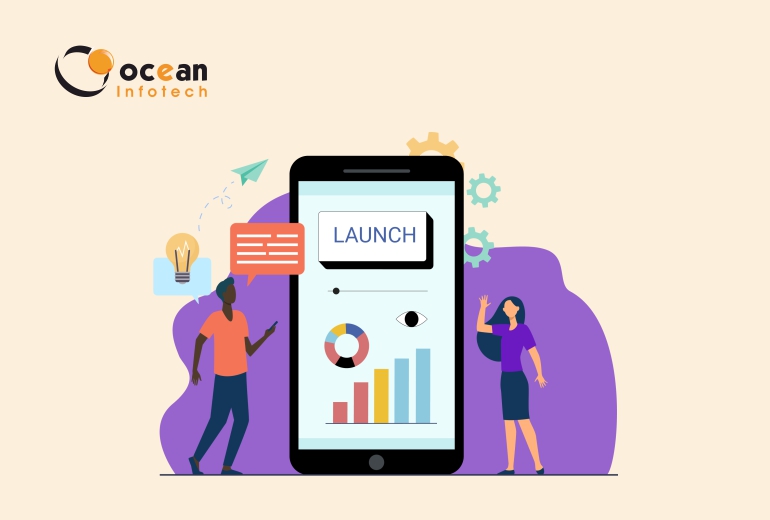It is essential to continue to engage users, resolve issues, and enhance the overall performance of the app. Read this article for the methods to implement following the launch to ensure that your app is up-to-date effective, and profitable. After you've launched the app, it's crucial to have a solid system in place to track and analyse your app's development. Tools specifically designed for this purpose don't just shed light on the app's performance as well as user behaviour but also reveal any potential issues. Continuous checks on the performance of your app are essential. With the help of various monitoring tools which make it is simpler to analyze your app's performance across various situations and on different devices. These tools give you real-time data about the speed at which your app is running as well as stability and the number of resources it's using (like the CPU and memory). It's essential to find and correct any bugs that went unaddressed in the process of developing the app process. This will ensure that users have the best experience. With the information gathered by developers, they can tweak the application, increasing the app's efficiency and speed of response. It is important to emphasize the necessity for this is vital, since any interruption or error could affect the user's experience and could cause them to leave. Knowing how users navigate through your application is crucial to its development. With analytics tools in your arsenal, you can analyze the user's interactions, their favourite features, areas where users leave or leave, and more. Such data can help highlight areas that need to be revamped or features that have a great reception from users. Analytics of users provide an indicator of user behaviour which will allow for future user-driven features and updates in the near future. In addition, they could help identify any problems or areas that can be altered to improve the user experience and be user-friendly. By continuously observing the user's behaviour, adjusting it and evaluating the impact of these changes and improvements, you can speed up the process of developing mobile apps. Consider feedback from users as your treasure chest. Reviews on app stores or direct feedback can provide an insight into the mind of the user, revealing what's a success and what's not so good. Inducing users to let their feedback be heard particularly in app stores, has two goals. It helps get feedback on your app's capabilities, user-friendliness and special features. Two, a plethora of positive reviews can enhance the app's popularity in the app store, bringing in more customers. However, influencing users to leave reviews is a skill. It's a good idea to contact users after they've had a wonderful experience using your application. A soft, non-pushy push to a rating or review could be very beneficial. Additionally, providing an easy means for users to share their grievances or connect via the app's support will help build a trusting relationship with your customers. It's not all about collecting feedback, but your actions with that feedback are tremendous. Responding to comments, specifically those that aren't so rosy sends a signal that you value and take action based on feedback. It's also an opportunity to transform a negative experience into a sweet one by addressing and solving issues. A systematic method to organize, prioritize and take action on feedback is essential. A team of just a handful of dedicated individuals to track and respond to the feedback of users can change the game. Using this feedback to improve the app shows an open and flexible attitude to the development of apps. This doesn't just boost the popularity of the app but also strengthens the connection with the app's users. Making sure your app is relevant through frequent updates is the key recipe to retaining user attention and ensuring that it is in line with the ever-changing guidelines for mobile application development. Consider the post-launch phase as the beginning of a race, aiming at the long-term viability and longevity that your app will achieve. The process of addressing bugs is similar to keeping the weeds from your garden after launch. However, through the testing that is conducted during the development process, bugs that aren't expected could be discovered. The process of rolling out updates to fix these bugs is a way to ensure the app's functionality and reliability. Quick resolution of bugs does not just improve the user experience but also builds trust as users appreciate the ongoing maintenance and speedy problem resolution. A systematic procedure for tracking bugs driven by feedback and analytics and then lining them up according to the impact they have on users is a smart method. Launching new features is your chance to keep the app relevant, lively and exciting. They could be refined versions of the existing functionality or totally new features that are in line with what the users want and what's trending in the marketplace. Making changes based on the feedback of users and market dives is a sure method to ensure that the app stays one step ahead of users' expectations. In addition, new features can be a way to engage existing users and attract new users. They tell a tale of improvement and growth and demonstrate a constant determination to deliver the best value. The process of creating a clear and concise plan to roll out new features and releasing this plan to users keeps them informed, thereby boosting the excitement. Following the launch, the spotlight shifted to securing users' attention and constantly promoting the app to attract new users. It's a cycle of effort that aims to keep the app in the spotlight while ensuring an enjoyable user experience. The marketing chariot must continue to roll even after a successful launch. Making yourself visible in an overcrowded market for apps is vital. Utilizing a variety of marketing channels including social media as well as collaboration with influencers and optimization of the app store (ASO) will ensure a steady flow of new customers. Promotions that are seasonal or themed and ads can be a way to tap into larger market trends and preferences, generating a buzz about your app. It's also beneficial to look into collaborations with other apps or platforms to promote mutually. If you keep the marketing embers going it keeps the excitement surrounding your app going, which helps to grow a user base in the course of time. Engaging users is a difficult task. 90 per cent of customers who engage with apps regularly will be more inclined to be long-term users. Making use of the right push notifications, coordinating events within the app and offering rewards or perks for frequent utilization are methods that can dramatically increase user engagement. Additionally, adding a bit of personalization, for example by creating customized interfaces or recommendations, could make the app more appealing and user-friendly. It's essential to find the sweet spot of communications to keep users entertained and well-informed without overburdening them. The analysis of user behaviour and the grouping of users according to their engagement levels through the app could aid in adjusting engagement strategies for various groups of users.Monitoring and Analytics
Performance Monitoring
User Behaviour Analytics
User Feedback and Reviews
Encouraging Reviews
Addressing Feedback
Regular Updates and New Features
Bug Fixes
New Features
Marketing and User Retention
Continuous Marketing
User Engagement Strategies


Post-Launch Strategies: Maintaining and Enhancing Your Mobile App
The moment you launch your mobile application is certainly an exciting moment. However, remember that it's not the last chapter It's more of beginning a new chapter. The time period that follows the launch is critical to the success of your app.
Let's discuss and work together for your project.
Just drop us line on info@oceaninfotech.co.in or just say HI in chat box, We would love to hear from you.

